Ancient woodland soils translocation
The construction of HS2 will affect ancient woodland sites across Phase One and Phase 2. Translocation of ancient woodland soils to a receptor site to rescue habitats that would otherwise be lost is one of a suite of proposed compensation measures.
HS2 has been strongly challenged regarding the effects of the project on ancient woodland and the proposed compensation measures of translocation. At present, detailed research in this subject area is considered less developed than for other environmental issues on the scheme and across the industry, although significant effort, and money is afforded to soils translocation as a compensation measure.
The number of ancient woodland soil translocations proposed, combined with it being carried out at different seasons and with significant variations in ancient woodland soil types, provided the project an unrivalled opportunity. It allowed us to understand the processes, refine the measures of success and add a significant contribution to the evidence base to help inform future works. There are a number of best practice and lessons learnt from the work carried out to date on ancient woodland soil translocation and salvage on HS2, in Warwickshire and Buckinghamshire, which are shared in this paper. This process has allowed us to develop the approach and methods and be able to share the insight gained.
Background and industry context
Ancient Woodland is defined as an area that has been continually wooded since at least 1600AD; there are approximately 52,000 ancient woodland sites in England. Natural England and the Forestry Commission states that ancient woodland is an irreplaceable habitat of importance for its wildlife, soils, recreation, cultural value, history, and landscape value [1] . Over hundreds of years, the intact soils in ancient woodlands have evolved into unique habitats with complex communities of trees, plants, fungi, microorganisms, and insects.
The construction of HS2 will affect ancient woodland sites across the route, and there are areas of woodland that will need to be removed to facilitate the construction of the railway line. HS2 Ltd recognises that ancient woodland is an irreplaceable resource. Through the Project Environmental Minimum Requirements (HS2 Ltd, 2017) [1], the project will continue to seek to further reduce the impacts of the Scheme on ancient woodland. Where effects on ancient woodland cannot be reasonably avoided then HS2 Ltd has committed to provide a range of compensation measures, one of which is ancient woodland soils translocation, the process of moving soils, to rescue habitats that would otherwise be lost. Translocation may also involve features such as trees, shrubs, individual plants, leaflitter and deadwood.
Ancient woodland has no statutory protection but is covered by the National Planning Policy Framework (Department for Levelling Up, Housing and Communities, 2021) [2] and is a material planning consideration. Therefore, there is a presumption against loss or deterioration of the habitat with a limited number of translocations previously undertaken and few case studies that research and document best practice and measures of success. The problem is compounded because the determination of success of the translocation process takes many years of monitoring due to the time that such an ecosystem takes to develop and mature.
HS2 has been strongly challenged regarding the effects on ancient woodland and the proposed compensation measures of translocation. At present, detailed research in this subject area is considered less developed than other environmental issues on the scheme although significant resources are afforded to compensation measures such as translocation of soils. The standard industry best practice guidance is CIRIA C600 [2] but there is limited robust published evidence of the effectiveness of ancient woodland soils translocation, and a paucity of long-term studies have been carried out. There are none known which look in detail at the soil and soil biota in retained ancient woodlands compared to translocated soils and newly created woodland habitats.
HS2 Ltd believes that re-using ancient woodland soils will provide a better outcome for these important soil resources which have developed over many hundreds of years compared to, for example, the disposal of this material or use in civils elements. The soil profile of an ancient woodland contains a unique seed bank and a biotic community including mycorrhizal fungi. Within the upper horizons, there are interactions between plant roots and soil microorganisms that are not found elsewhere and have established from being undisturbed for centuries.
Approach
HS2 Ltd have prepared an Ancient Woodland Strategy for Phase One [3] outlining each directly affected ancient woodland and the compensation measures to be taken in response to the predicted losses at these woodlands.
Where feasible, there will be relocation of the existing ancient woodland soils from the donor site affected to nearby compatible receptor sites (i.e. receptor sites with similar soils, hydrology and topography). This involves a specific and careful process designed to maintain the structure and valuable biodiversity that currently exists in the soils.
HS2 Contractors have designed and planned the ancient woodland translocation work in line with HS2 standards and best practice. Methodologies for the tree felling works and the soil translocation work are produced by specialists in the supply chain and assured by our Contractors. Natural England, the Forestry Commission and the Woodland Trust are engaged in the process of ancient woodland soils and ‘feature’ translocations and they provide comment on the proposals in advance of works.
Outcomes and learning
The following sections highlight some of the key best practice and lessons learnt during the translocation of soils and woodland features on Phase One of HS2.
Soil survey and planning
Accurate description of an ancient woodland soil that is to be translocated (donor site) and of the potential receptor sites is essential in guiding the soils removal process and providing a baseline reference for monitoring soil development. Good soil data should come from both desk study and survey by a qualified soil scientist and is used to:
- design and plan the work, including the selection of the most suitable translocation process;
- guide the overseeing soil scientist and ecologist;
- provide a permanent record of the original woodland soil against which soil development in the receptor site can be compared; and,
- help replicate the soil profile from donor to receptor site (along with other data such as hydrological conditions and topography).
Deciduous woodland soils are very different in their upper layers to agricultural soils. They are characterised by seasonal accretion and decay of leaves and other plant debris that become humified and intimately mixed with the upper few centimetres of mineral soil. These dark-coloured upper layers may be only 10-15cm thick, compared with 25-30 cm in agricultural topsoils. Woodland soil profiles also tend to be less uniform than agricultural ones, with topsoil material filling old root channels or being buried by uprooting during tree fall (Figure 1).
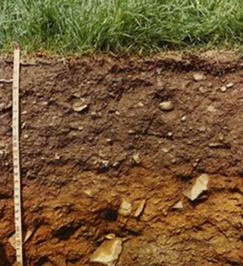
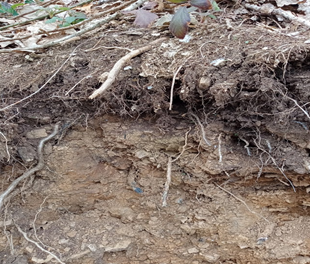
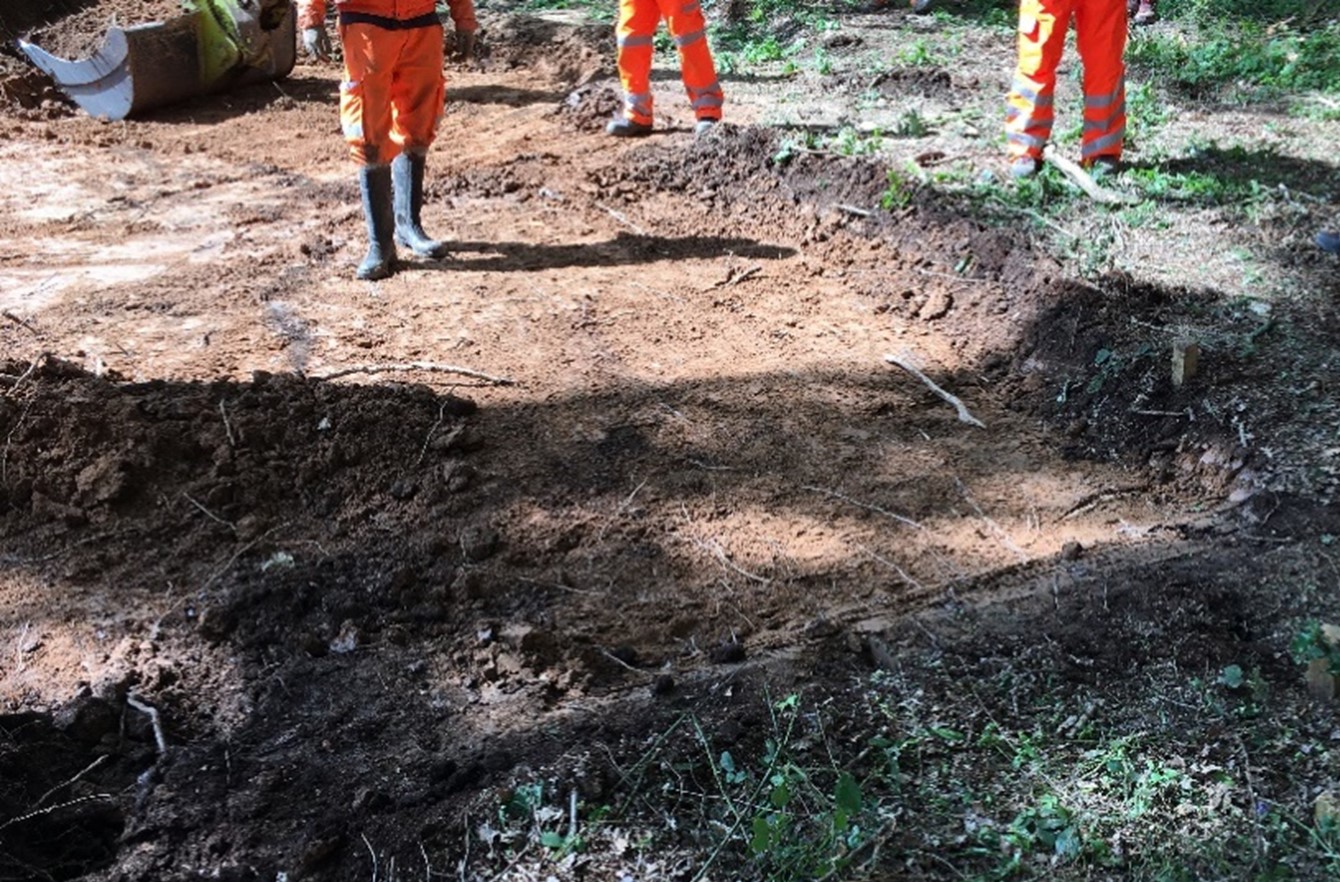
Woodland Ah horizons recorded by the Soil Survey of England and Wales in their publications typically have organic matter contents (by loss on ignition) in the range of 8 – 20%, whereas agricultural topsoils (with the exception of old pastures) typically have organic matter levels in the range of 2.5 – 5%.
Published data, such as soil maps[4] and geological maps [5], should be reviewed prior to surveying as this will provide a background and identify what to expect in the field. The British Society of Soil Science (BSSS) document Soil and Land Quality[6] describes sources of useful information.
The site survey results, based on auger bores and representative pit descriptions, are needed in good time to inform the design of the works which may affect length of the translocation programme, method of translocation suitable (i.e. loose tipping or turf movement), machinery required and access. The Soil Survey Field Handbook [7] describes how to identify and name these upper layers (see Inset).
Soil pits are a mandatory requirement of HS2 soil surveys for woodland translocation, as auger bores alone cannot identify features such as rooting, depths of bulbs and corms, subsoil structure and stone content.
L – Fresh litter deposited during the current or previous annual cycle. It is normally loose and the original plant structures are little altered. (Note, this layer’s thickness is measured from above the soil surface, with zero at the base, e.g. 3 – 0 cm).
F – Partly decomposed or comminuted litter remaining from earlier years in which some of the original plant structures are visible to the naked eye. (Note, the top of this layer represents the soil surface for measuring horizon depths).
H – Well decomposed litter, often mixed with mineral matter, in which the original plant structures cannot be seen. (Note, this layer may be indistinguishable from the Ah horizon below, in which case the Ah takes precedence).
Ah – An uncultivated horizon containing an intimate mixture of mineral soil and humified organic matter. Incorporation of organic matter results from biological activity rather than artificial mixing.
Below, are the upper and lower subsoil E, B and BC horizons that are similar in most respects to agricultural soils.
These categories apply to naturally well drained soils. Woodland soils in wetland habitats generally have organic or peaty O horizons below the F and H layers, resting on a gleyed Bg horizon.
Below is an example of a well described topsoil and upper subsoil in an ancient woodland in Paul’s Wood, Notley Essex [8] and Figure 2 shows a soil survey example from ancient woodland. An H horizon is not described as it was indistinguishable from the upper Ah horizon
Horizon cm
L. 5-0 Leaf litter of oak, birch and poplar with hornbeam seeds and dead twigs.
F 0-3 Very dark greyish brown (10 YR 3/2) partially decomposed leaf litter.
Ah 3-7 Dark brown (10 YR 3/3) very slightly stony clay loam; very weak soil strength; moderately developed fine fissures; common very fine fibrous live roots and few medium woody dead roots; moderately developed fine subangular blocky structure; earthworms; abrupt irregular boundary.
B(g) 7-40 Yellowish brown (10 YR 5/6) slightly stony clay loam with few fine very pale brown (10 YR 7/3) mottles with few fine strong brown (7.5 YR 5/8) mottles and ferrimanganiferous nodules; earthworm and root channels containing Ah material; moderately developed very fine fissures; few coarse woody live roots and few dead coarse woody roots; moderately developed fine and medium subangular blocky structure; moderately firm ped strength; earthworms; diffuse wavy boundary.

The ancient woodland soils at the donor site should be mapped out in detail using a grid system and demarcated in the woodland (Figure 3). This should include mapping areas of ancient woodland soils which are considered low value and/or unsuitable for translocation, as assessed by a soil scientist and ecologist. Reasons for low value may be compaction from pedestrian traffic caused by protester activity and associated security or due to the presence of invasive non-native species. A similar grid system should be mapped and demarcated at the receptor site such that detailed records can be kept of which soils have been translocated where, using what process and what treatment they have received.
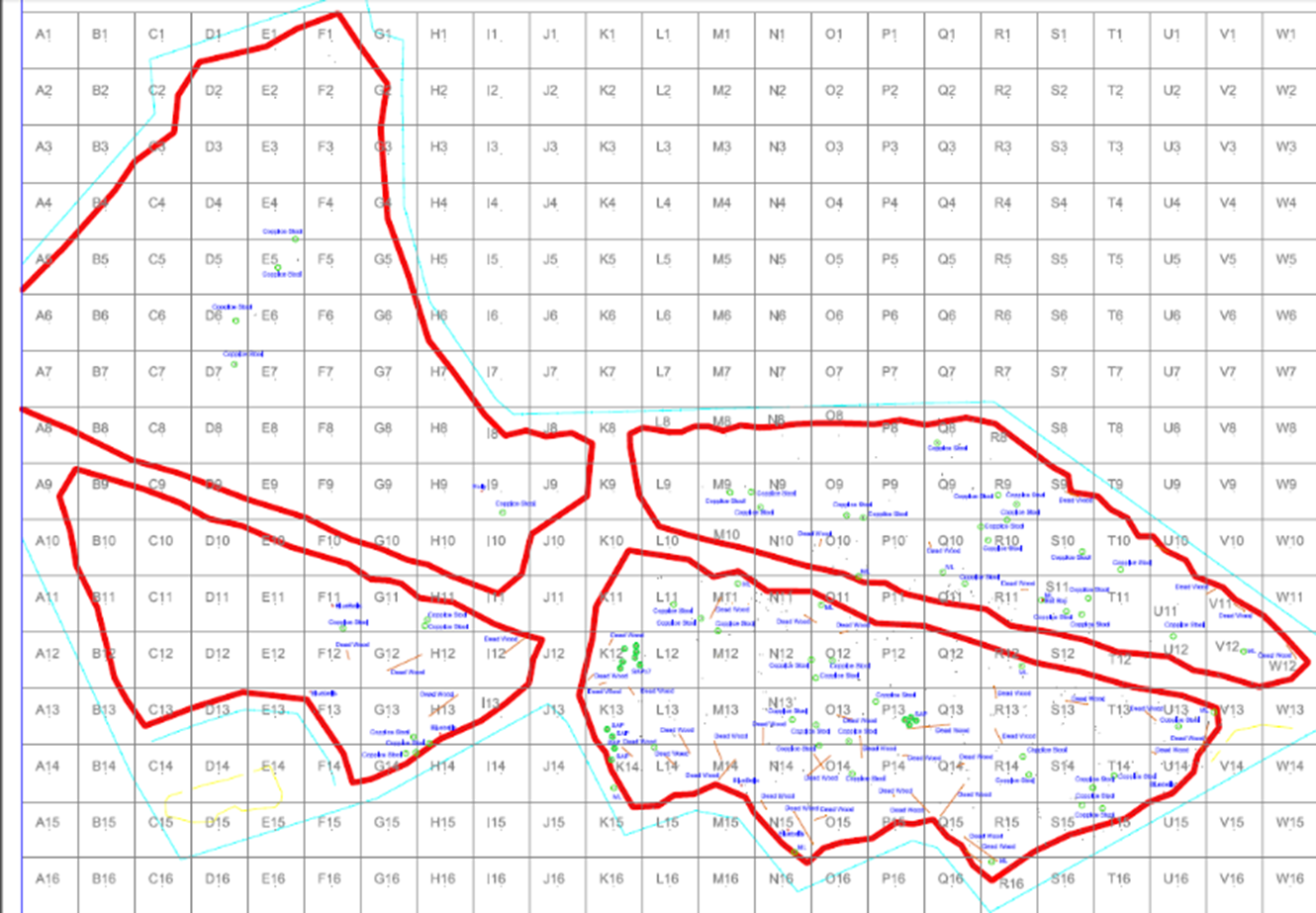
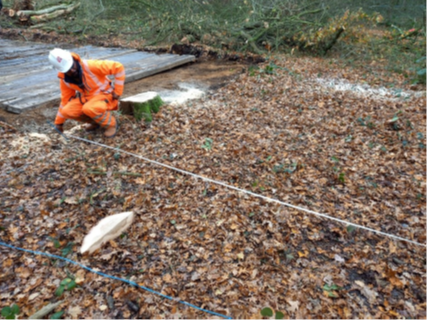
Site supervision and record keeping
Work on site should be guided by a qualified and experienced soil scientist to make sure soils are correctly handled. HS2 expects professional soil scientists to have graduated in a relevant science subject, have at least five years of relevant field experience and have, or be adequately qualified for, full professional membership of the BSSS. The soil scientist should work with a professionally qualified and suitably experienced Ecological Clerk of Works (ECoW) and site supervising team to decide whether soils are suitable for translocation on each day of the work. Forestry/ horticultural expertise may also be required to help with decisions on the translocation of coppice stools, trees and saplings and dealing with invasive non-native plant species all of which could affect the approach to soil translocation.
Method statements for the translocation and handling of soils need a flexible approach to enable specialists to make decisions on site. This could include the provision of a soil consistency test to inform whether works should cease when the weather conditions are not suitable for translocation.
Daily soil checks are required during the translocation programme of both donor and receptor sites to check if soils can be translocated and whether any remedial measures are required, such as watering. Some of the checks may be delegated, although final sign off and decision making requires input from the soil scientist. HS2 produced a field guide to soil handling conditions (Tables 1 to 3) to help soil scientists in their decision making during woodland soil translocations.
Daily technical notes should be produced during the soil translocation, to document methods implemented on site (see supporting information). Detailed site records should include:
- dates, times and details of the soil scientist on site;
- site photographs and videography;
- detailed records of soil depths, stripping thickness, where soil is translocated from the donor site and moved to the receptor site using a grid pattern of donor to receptor soils;
- identification and justification for any areas which have been tracked over or which will not be translocated;
- information on any treatment of soils at donor or receptor sites (for example if tracked soils are translocated, watering, whether any decompaction or ripping has been implemented).
Soil preparation and management
The best methods for translocation depend on site conditions including moisture content and depth of soil. Movement of soil in turves is preferred to maintain the soil profile, plant bulbs/roots and associated mycorrhizae. However, this may not be possible due to depth of soil, presence of trees, bushes and their root systems and access constraints, in which case stripping and loose tipping of soil in separate layers may be required. Where loose tipping was implemented on some sites a dedicated dumper was used for the organic topsoil layer, and a separate dumper for the deeper topsoil layer Figure 4.
Donor site soil stripping methodologies used at Decoypond Wood, Buckinghamshire
Method A: Soil stripped in two layers of varying depth, following the natural variations in depths and loaded into two separate dumpers. Size of area stripped measured. Spread at the same depth from which it was stripped.
Method B: Methodology to handle soils with bluebell bulbs or other ancient woodland indicator species. Soil stripped carefully in one layer of varying depth and loaded as one mixed horizon into dumpers. Size of area stripped measured. Spread at the same depth from which it was stripped.
Method C: Methodology to maintain horizon structure intact and undisturbed, particularly in core areas of bluebell bulbs or other ancient woodland indicator species (turf translocation). Only suitable for areas without large roots. Soils cut carefully in one layer, taking a slightly deeper strip to take a small amount of subsoil and left in the bucket which is demounted from the excavator for transportation to receptor site.
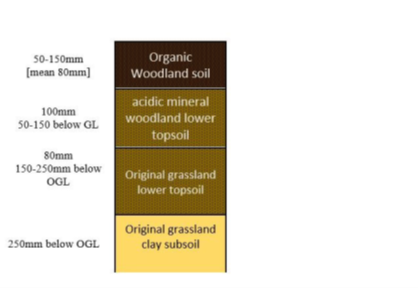
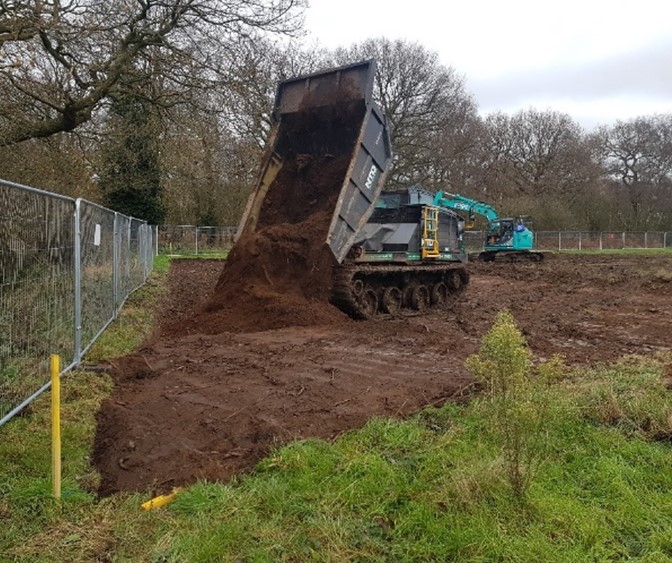
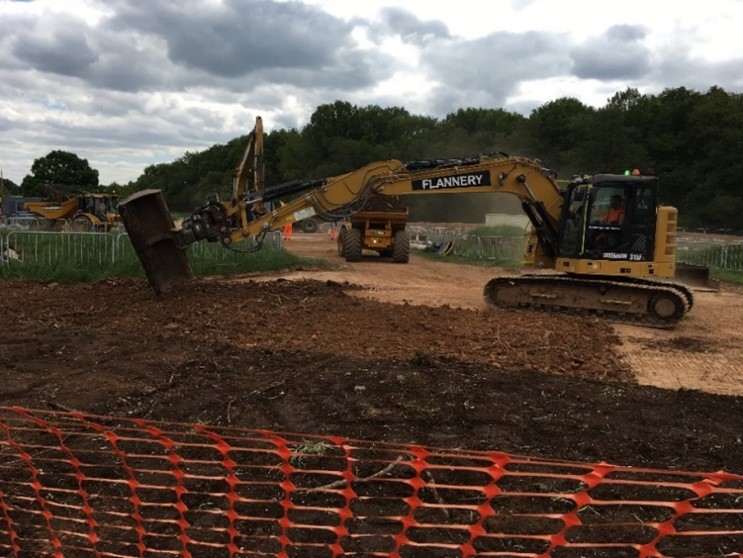
Although the soil surveys prior to works help to design and plan the translocation, the soil surveys are only a sample. There will be a need to respond to site conditions such as variable material depths and weather conditions. For example, at some sites it was impossible to translocate the litter and topsoil separately due to the thinness of the layers (e.g. Unnamed Woodland south of the B4115 Ashow Road in Stoneleigh, Warwickshire). The soil scientist on site may need to check depths for soil stripping several times a day and there may be some compromises on site made between soil profile and preservation of bulbs and roots. For example, stripping at ancient woodland soils in Cubbington and Kenilworth, Warwickshire, was undertaken to preserve the bluebells, anemones and microflora in the top horizon rather than accurately stripping upper (LFH) horizons; so some of the Ah layer (2-4cm) was also lifted with the LFH layer. If important vegetation was not present, then the LFH layer was stripped as one to preserve the organic matter at the surface, but due to very variable depths over short distances there was inevitably some mixing of the LFH and Ah layers. In most situations 30 cm is probably the maximum depth of turf which would be lifted, although when trying to lift small trees a spade bucket will go deeper to protect the root ball.
Good site management during soil translocation work should include:
- Soil Scientist to hold an initial briefing to educate the whole site team about why soils are fragile and the need to be handled with care. Daily briefings can also be used to point out agreed access tracks and pedestrian walkways to prevent accidental incursion and any ecological exclusion zones, such as around birds’ nests, which may change during the course of works. Briefings regarding the fragility of ancient woodland soils should also be given to any teams that may be undertaking ecological mitigation and vegetation clearance prior to soil translocation (Figure 5).
- Avoid having all teams working in the same place at the same time (tree shearers, grapples, bat mitigation, soil movement). It would be better to progress through woodland with separate teams at separate locations.
- Although it may be preferred to clear understorey as soon as possible to prevent birds nesting, teams should consider retaining some brash/scrub on site for as long as possible so soils remain relatively dry before translocation in wet weather, or to prevent soils from drying out in hot weather. Retained brash piles can also be used to soften the fall of trees felled thus avoiding soil damage.
- Plan the works to reduce the length of exposure of donor soils after tree clearance and of receptor subsoils after topsoil removal to prevent drying or waterlogging (depending on weather conditions). Donor soils should not be stored but should be moved immediately to the receptor site.
- Use experienced machinery operators. Carefully stripping separate layers within the topsoil as directed by specialists on site requires precision and only skilled machinery operators should be used in soil translocation works.
- Have access to water in case soils are being translocated in drier conditions and need damping. After donor placement it is imperative the soil moisture is monitored until some form of cover is established and watered if necessary. Without vegetation cover to give shade donor soils will dry very quickly; plants within the translocated turf/soil may have had much of their root system truncated and be less drought tolerant. Note that if a source of running water is nearby it is possible to extract up to 20m3 per day without needing an abstraction licence.
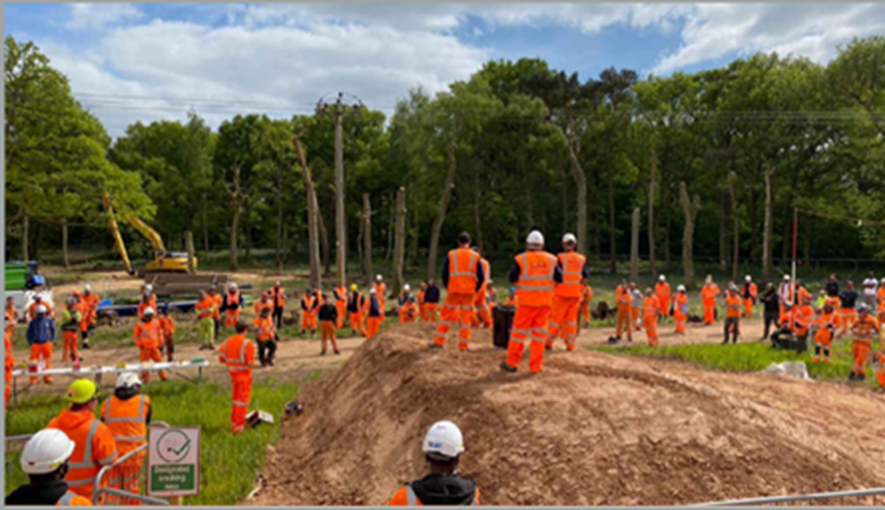
Site access issues and tracking over soils
The tracking of machinery across ancient woodland soils should be avoided to prevent compaction or mixing of horizons within ancient woodland soils. The primary concern is the scuffing and damage to the fragile litter layers) and the upper section of the A or O horizons (topsoil including bulbs and rhizomes) from vehicles changing direction and turning on soils.
In some locations on HS2, there was a need for limited tracking of machinery over ancient woodland topsoil. This was due to issues including: protestor activity, ecological constraints and resultant exclusion zones, the requirement to remove large pieces of felled vegetation to reduce the risk of creating species habitat and needing to conduct ground investigation prior to soils mitigation work. To reduce impacts on the ancient woodland soil the following mitigation measures were implemented during works in Warwickshire and Buckinghamshire:
- All works were completed under the full-time supervision of a suitably experienced soil scientist and ECoW.
- The site management teams identified and planned access routes, traffic management (including turning areas), and public rights of way in advance of the start of works. Access routes were carefully planned to coincide with areas of low value (as mapped on a grid system) or along permanent woodland rides within the design (Figure 6).
- At sites in Warwickshire low ground pressure machines were used for soil works (JCB JS145 long reach tracked excavator, with 1.2m wide tracks, with a ground pressure of 2.43 psi, and a mini digger of 6.2 psi). To facilitate access for drilling rigs low ground bearing pressure machines were used including a tracked dumper C505-5TV, exerting a ground pressure of no less than 3.03 psi and no more than 4.80 psi, when fully laden, a Komatsu 3T excavator, with 3.5 psi, and a Bobcat/Avant (2-4 psi). Typically, human footfall exerts 8-10 psi. Ultra-low ground pressure 15m long reach excavators were also used with tree shears/grapple to reduce plant movement. The use of this machinery in suitable ground conditions should not result in significant ground compaction or mixing of soil horizons and this type of machinery can also be used to track over bogs/wetlands.
- Soft-felling or rigging of all hand cut tree limbs to prevent soil compaction (regardless of whether these had bat roost potential features or not).
- Machinery tracked in straight lines, and only changed direction on low value soils (it is the change of direction in an excavator that scuffs and damages the soil; when tracking in straight lines there is less ground pressure than a human foot). In areas where turning of vehicles is necessary, plastic track matting was installed to prevent risk of scuffing topsoil.
- Use of pedestrian matting at donor sites to direct footfall and reduce compaction.
- Use of a grid system to keep detailed records for the tracking of soil movements at both the donor and receptor sites. Whilst it was not anticipated that soils that have been tracked over will require any treatment at the receptor site, the ongoing maintenance and monitoring programme for the receptor sites can be used to identify if this is needed.
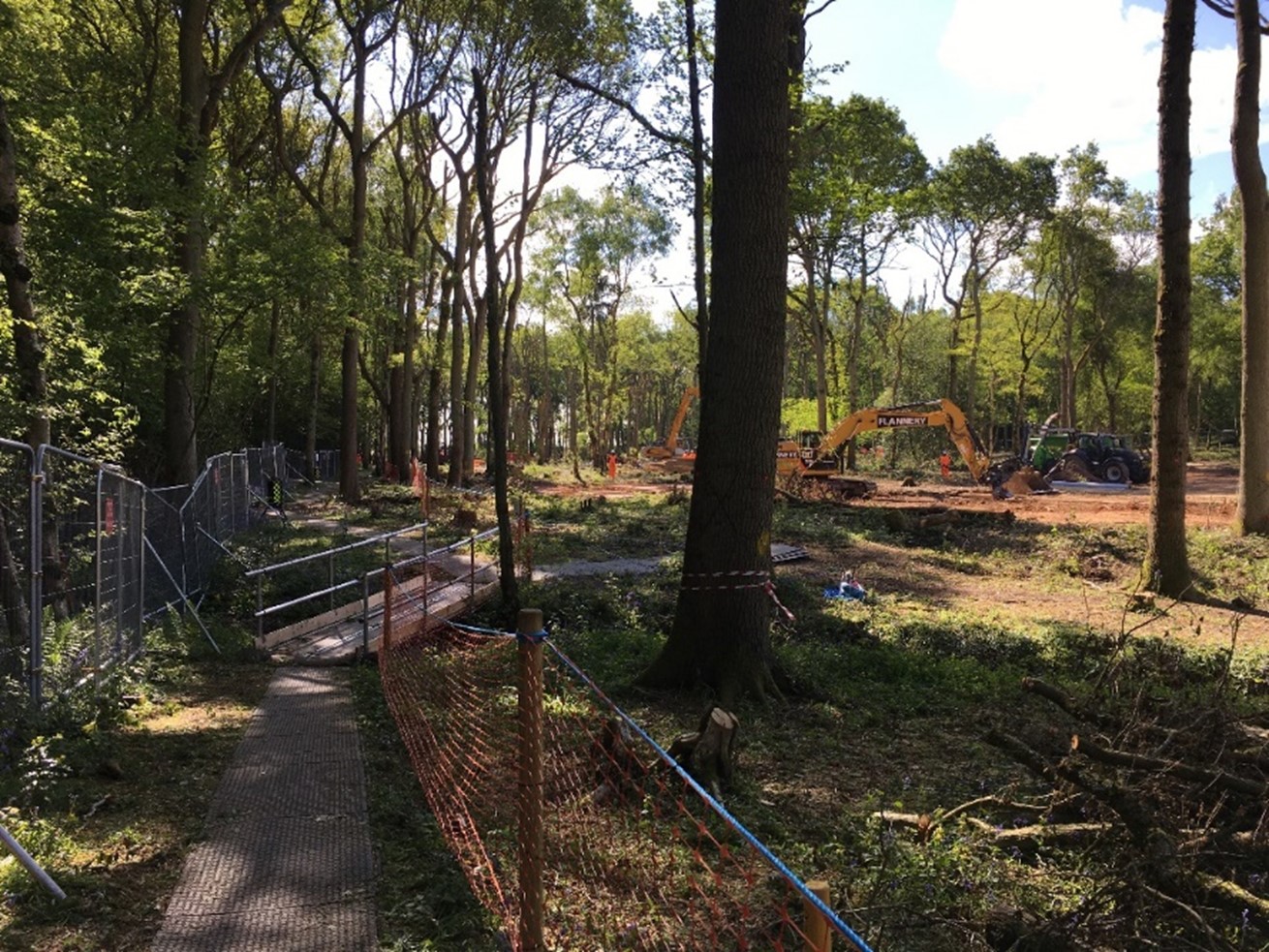
Seasonality of works
CIRIA C600[2] is recognised by practising ecologists as the main document to inform the habitat translocation process and is currently considered best practice. The document states that “All translocations should take place in the dormant season for terrestrial habitats…This is especially appropriate for woodland…”. HS2 considers the dormant season as October to February, inclusive.
In some cases, HS2 contractors have been unable to move ancient woodland soils within the dormant season due to programme issues. HS2 Ltd believes that re-using ancient woodland soils will provide a better outcome for these important soil resources which have developed over many hundreds of years compared to, for example, the disposal of this material to landfill. Where soils have had to be moved outside of the dormant season this has been identified as soil salvage.
Best practice guidance on conducting work outside the dormant season is largely due to reducing impact on plants. From a soils perspective, soil stripping for translocation would ideally start in September when soils are warm but toward the end of the plant growing season. This reduces the risk of waterlogged and frozen ground conditions over winter which can reduce the effectiveness of translocation operations and introduce the need for additional controls such as water management and track matting.
Dealing with heavy textured subsoils and drainage issues
Usually, operators should not move soil if:
• It is raining or just been raining sufficiently to change the soil handling characteristics and form puddles on the surface.
• Moderate or heavy rainfall (> 10mm/24 hours) is confirmed as imminent.
• The ground is frozen or snow covered.
Heavy clay loam and clay subsoils were present on some of the HS2 ancient woodland receptor sites, particularly in Warwickshire. The heavy subsoils at receptor sites were showing signs in early October 2020 of being above field capacity and at risk of smearing and compaction during handling. Evapotranspiration had ceased and soils remained wet until spring. Working on subsoils above field capacity causes compaction that cannot be remedied by ripping while they remain plastic and smearable. Compaction exacerbates water retention on the surface resulting in saturation and pools of standing water.
Woodland translocation in winter was necessary to meet best practice relating to seasonality. However, this led to handling soils whose moisture state had exceeded their field capacity. HS2 produced field guidance for Contractors on assessing mineral soil handling conditions during ancient woodland soils translocation to reflect the difficult working conditions encountered in the wet autumn of 2020 (Tables 1 to 3).
Different soils will have different levels of resilience to structural damage during handling (Table 1). To determine the suitability of soil conditions in advance of handling, it was advised that soils were tested at several evenly distributed sampling points within each soil handling unit, the number of sampling points to be determined by the contractor’s soils specialist. At each sampling point one sample per soil horizon to be stripped was advised to be taken and assessed according to its moisture state (Table 2) and consistency (Table 3). Decisions were advised to be based on at least 80% of the samples passing the ’tests’.
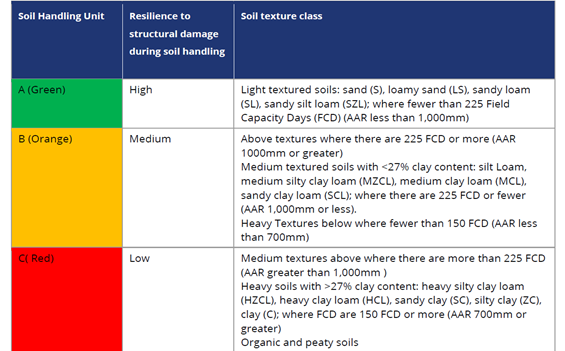
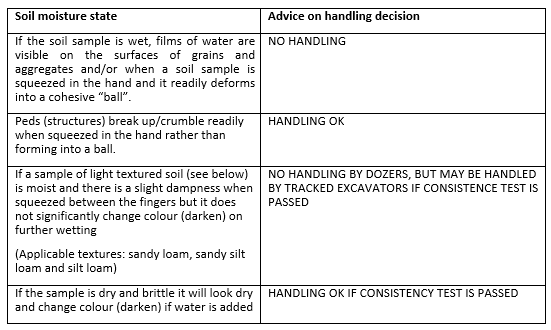
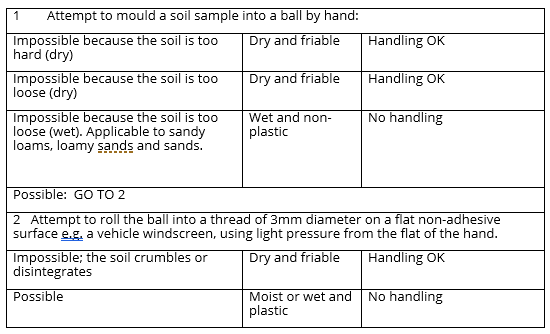
To ensure the woodland soil translocations had the best chance of success and to reconcile soil handling conditions and ecological safeguards in soils that exceeded field capacity, a hierarchy of controls were agreed (see box below on first, second and third order controls).
The soil conditions on the receptor sites needed to be continually reviewed and assessed to determine the correct control option to reduce damage to the soil structure. Records were kept of conditions and decision making in relation to the implementation of these controls.
Topsoil from the receptor site should be stockpiled until it is used elsewhere. Soils which have been stripped when wet or plastic in consistency will need to undergo some form of soil reconditioning, typically windrowing and re-stockpiling, before they will be considered suitable for reuse. All soil reconditioning works, including windrowing and re-stockpiling should be regularly inspected and signed-off by the soil scientist.
First order controls – good site management (by default)
- Only expose the receptor area immediately before it is ready to receive donor soil. Where this is not possible, cover receptor areas where feasible to prevent rain pooling on the surface of the subsoil.
- Drain pools and large puddles (subject to any required discharge consent or agreement with neighbouring landowners, if the water is to enter a watercourse).
- Divert surface water away from working areas.
- Consider the use of grips (shallow interceptor drains < 0.3m, temporary or permanent) and drains within receptor areas to remove rainfall.
- Consider grips and drains within areas of the site that have already been stripped to minimise standing water on site.
- Use suitable silt management systems where necessary such as vegetation, straw bales or silt fencing with additional silt management measures on site ready to be deployed in events such as major rainfall or pump failure.
- Consider design of the subsoil microtopography to direct surface water away, such as using ridge and furrow arrangement.
- Pumping is an option for rapid removal of large amounts of standing water.
- Do not allow traffic on receptor subsoils.
- Where movement over subsoils cannot be avoided, use ground mats to prevent surface conditions deteriorating, but this should be kept to a minimum and not used as a pretext for widespread and avoidable trafficking. Any areas where track matting is used should be mapped and recorded to inform future monitoring.
- Keep travel speeds down. Damage increases disproportionately with speed.
Second order controls – changes to working practice
- If soils fail the conventional handling tests, then under the supervision of a soil scientist it may be acceptable to try translocating test loads. If the structure survives the lifting, transport and laying process translocation may proceed with caution.
- Only rip the subsoil when necessary, especially if the subsoil has not been damaged by traffic. (separate permission on HS2 sites would be needed where ripping was not going to be carried out) Subsoiling will not be effective unless the soils are drier than field capacity which otherwise risks smearing and puddling the soil.
- Contractors who use machine operators with experience of working on heavy soils to reduce risk of compaction and soil damage will find they are able to work additional times and days, with a better outcome in terms of soil conditions.
- If the receptor site stripping process is creating a smear or pan, even when using an experienced machine operator, then loosen only to a depth that breaks the pan. Subsoil ripping will not be effective in wet soils and may exacerbate the problem of waterlogging. Look at alternative options such as shallow scarification or raking.
Third order controls – abandonment
There may be areas where water logging is a problem to the extent that the movement of soils is extremely unlikely to achieve a successful translocation outcome. There may also be areas of the donor site which are unsuitable for translocation, such as those damaged by the presence of protestors. Areas where the woodland soils are not suitable for translocation need to be identified and agreed with a suitably qualified and experienced soil scientist, with clear reasons detailed and clearly demarcated by the contractor. In these situations, additional woodland compensation may be required, such as larger areas of planting in the receptor site. This approach is supported by measures outlined in the HS2 Phase One: London – West Midlands Ancient Woodland Strategy (3).

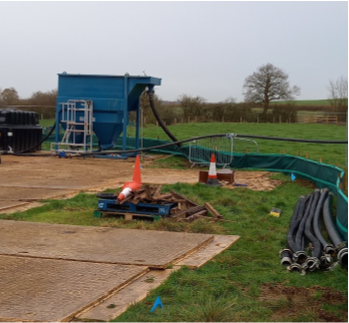
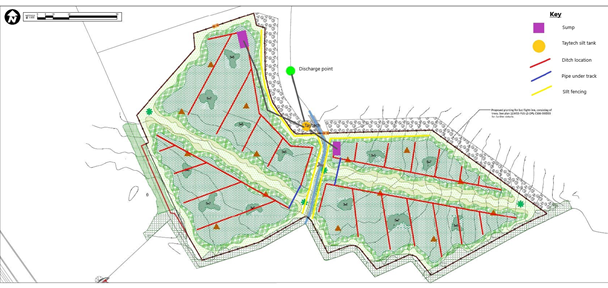
Recommendations and conclusion
The key recommendations for soil work in relation to ancient woodlands are:
- Plan start dates for soil survey, preparation and translocation within an integrated programme taking into account other constraints (such as ecology seasonal windows for mitigation).
- Current guidance on translocations is to for these to take place in the dormant season for terrestrial habitats (October to February, inclusive). However, soil stripping for translocation would ideally start in September when soils are warm and at the end of the plant growing season, and to reduce the risk of waterlogged and frozen ground conditions.
- Use qualified and experienced soil scientists, ecological clerk of works and machine operators as part of the team and get specialist contractors on board as soon into the process as possible (i.e. during the design and planning phase).
- Have a design in place to cover access, clearance and translocation methods based on survey data but be flexible in the approach (within set parameters) according to site conditions. Have plans for how to deal with poor site conditions such as wet weather and poor drainage.
- Carry out daily soil checks during the translocation work and implement a rigorous recording system, include grid-based records for donor and receptor sites and daily soil scientist technical logs.
Immediately following translocation, the primary indicators of success should be: similar soils depths as those at the donor site; good turf integrity (i.e. well laid with no gaps or depressions, unless this is to purposefully mirror topography at the donor site); and no significant compaction of the soil structure which can cause poor drainage, wind rock, stunted plant growth and may affect the survival of soil microorganisms.
Acknowledgements
The HS2 Ancient Woodland Steering Group was set up in 2020 to share lessons and best practice in planning and carrying out work at ancient woodland sites. HS2 ecologists, soil specialists and landscape managers are part of this forum as well as our Contractors, the Forestry Commission and Natural England. The authors thank members of the forum for contributions to, and comments on this article.
References
- Environmental minimum requirements for HS2 Phase One. Published 25 November 2013, Last updated 9 June 2017. These documents accompany the High-Speed Rail (London – West Midlands) Act 2017 and include the Code of Construction Practice.
- National Planning Policy Framework. Department for Levelling Up, Housing and Communities. Published 27 March 2012, last updated 20 July 2021.
- Forestry Commission and Natural England. Guidance Ancient woodland, ancient trees and veteran trees: protecting them from development. Published 13 October 2014, last updated 5 November 2018.
- Anderson, Penny. Habitat translocation – a best practice guide. CIRIA C600. London, Highways Agency & CIRIA. 2003.
- HS2 Ltd. High Speed Two, Phase One: London-West Midlands Ancient Woodland strategy. August 2017.
- Soil Survey of England and Wales Bulletins, associated maps and regional/local maps and associated data on LandIS.
- British Geological Society (BGS) mapping.
- British Society of Soil Science. Soil and Land Quality. 2021.
- Hodgson, J.M. (Ed.) Soil Survey Field Handbook: Describing and Sampling Soil Profiles. Soil Survey and Land Research Centre, Silsoe. 1997.
- Allan R.H. and Sturdy, R.G. Soils in Essex III: Sheet TL71 (Little Waltham). Soil Survey Record No. 62. Rothamsted Experimental Station. 1980.
Supporting Materials
Soil handling record sheet example.
Individual site case studies (Ashow Road and Decoypond Wood)
Best Practice – Donor and receptor cell feature mapping
Best Practice – Environmental Management Low Carbon Sustainable Solutions
Best Practice – Placement of fallen deadwood
Best Practice – Placement of standing deadwood
Best Practice – Semi permanent water features
Best Practice – Surface water and silt management
Peer review
- David Prys-Jones HS2 Ltd
- Laura Harding HS2 Ltd


